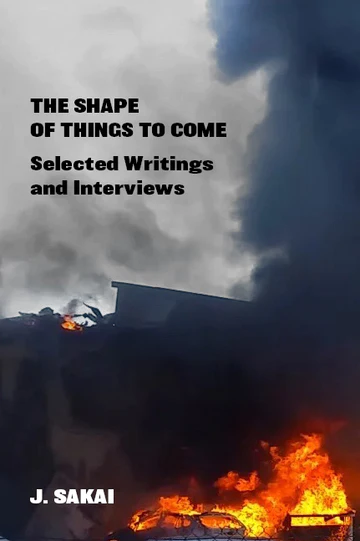McAntiwar and More: Gabriel Kuhn on J. Sakai’s “The Shape of Things to Come” [LeftTwoThree.org]
 [Originally posted to LeftTwoThree.org]
[Originally posted to LeftTwoThree.org]
A review of J Sakai, The Shape of Things to Come (Montreal: Kersplebedeb, 2023).
Last month, we looked at the Kersplebedeb release A Brilliant Red Thread, an anthology of writings by Don Hamerquist. This month, we’re looking at a somewhat similar release by Kersplebedeb, The Shape of Things to Come, an anthology of writings by J. Sakai. The main difference is that most of Hamerquist’s book consisted of emails and online forum contributions unavailable to a broader public before, while most texts in The Shape of Things to Come were previously published, so avid Sakai fans might be familiar with a number of them.
J. Sakai remains somewhat of an enigma, even if his texts reveal a Japanese-American background and decades of organizing within the radical left. Sakai is best-known for his 1983 underground classic Settlers: The Mythology of the White Proletariat. An interview titled “When Race Burns Class”, revisiting Settlers in the year 2000, is one of the longer texts included in The Shape of Things to Come. The transcripts of a 2003 radio interview with Ernesto Aguilar, once a prominent figure in the Anarchist People of Color (APOC) network, touches on similar subjects.
Sakai has his own way with words, and reading his articles and interviews usually is as entertaining as it is educational. It’s stream of consciousness in non-fiction, a bit like podcasts without the audio. At times, reading through the interviews, you find yourself wondering, “Wait a minute, what was the question again?”, but it’s all part of the fun.
Perhaps not every comment hits the mark, but most do. Among the exceptions is the suggestion that “the 1970s and 1980s mass protests [that] regularly shook European cities, with the black-clad ‘masked ones’ regularly darting out of the crowds to hurl their own missiles at the riot police” only had one result, namely, “the Europe-wide reemergence of fascism into the daylight as a political force.” I think that’s a little unfair. I’m not even sure there’s a particular link between both phenomena, but even if there was one, the reemergence of fascism would not have been the only result of said mass protests, as they also generated an impressive infrastructure of radical projects and spaces, a strong antifascist movement, and an inspiring level of anti-state militancy, all of which should count for a little more than nothing.
It might be a generational thing, but what I enjoy most about reading Sakai is that you find a critique of white supremacy and the white left rooted in material analysis. It’s different from many such critiques today, and it’s refreshing. Needless to say, that’s a personal view.
Out of the pieces I hadn’t read before, “Beyond McAntiwar” was probably my favorite. For the sake of humanity, it’d be great if this 2005 take on US politics and the global situation had been proven wrong by now, but it hasn’t. The shape of things to come indeed, and it’s not going to be pretty.
I also very much enjoyed two texts from the 1980s: “Pseudo-Gangs”, chronicling the Mau Mau rebellion in Kenya, and “What Happened to the Zimbabwe Revolution”, analyzing, well, the revolution in Zimbabwe. The latter also includes my favorite subheader in the book: “Civil Rights Instead of Liberation = Neo-Colonialism”.
“Aryan Politics & Fighting the W.T.O.” and “The Green Nazi: An Investigation into Fascist Ecology” are very valuable contributions to the far-right engagement with environmental politics. Unsurprisingly, Peter Staudenmaier is quoted. His 2021 release Ecology Contested: Environmental Politics between Left and Right was reviewed on this blog before. On a different blog, I also reviewed Sakai’s 2017 book The ‘Dangerous Class’ and Revolutionary Theory: Thoughts on the Making of the Lumpen/Proletariat. One of its chapters, “Theory Mao Tossed to Us”, is included in The Shape of Things to Come in abbreviated form.
There are some sweet editorial touches to The Shape of Things to Come, such as dividing an interview conducted by Kersplebedeb with Sakai between 2020 and 2022 into two parts – the first serving as an intro, the second as an outro. It frames the texts selected for the anthology nicely. There are also plenty of illustrations in the characteristic Kersplebedeb style, blending anarcho-punk cover art, the aesthetics of 1980s zine culture, and in-your-face imagery.
An editorial feature that might have become standard without me noticing it (see also the review of a recent Walter Rodney anthology by Verso) is to take shortcuts when it comes to bibliographical references. It might be my nerdy side, but I would indeed like to know more about a piece such as “Beyond McAntiwar” than just the year it was written in. For example, why was it written, and for whom? Has it been published before? I’m also not sure if everyone knows that S1 was an antiimperialist journal from the 1980s. To just insert the name in brackets, together with the year a text was published in, mainly looks like secret coding.
Well, that’s all “complaining at a high level”, as we German-speakers say. The Shape of Things to Come is a great book that no partisan of revolutionary literature should miss.
Gabriel Kuhn
(April 30, 2023)
Leave a Reply